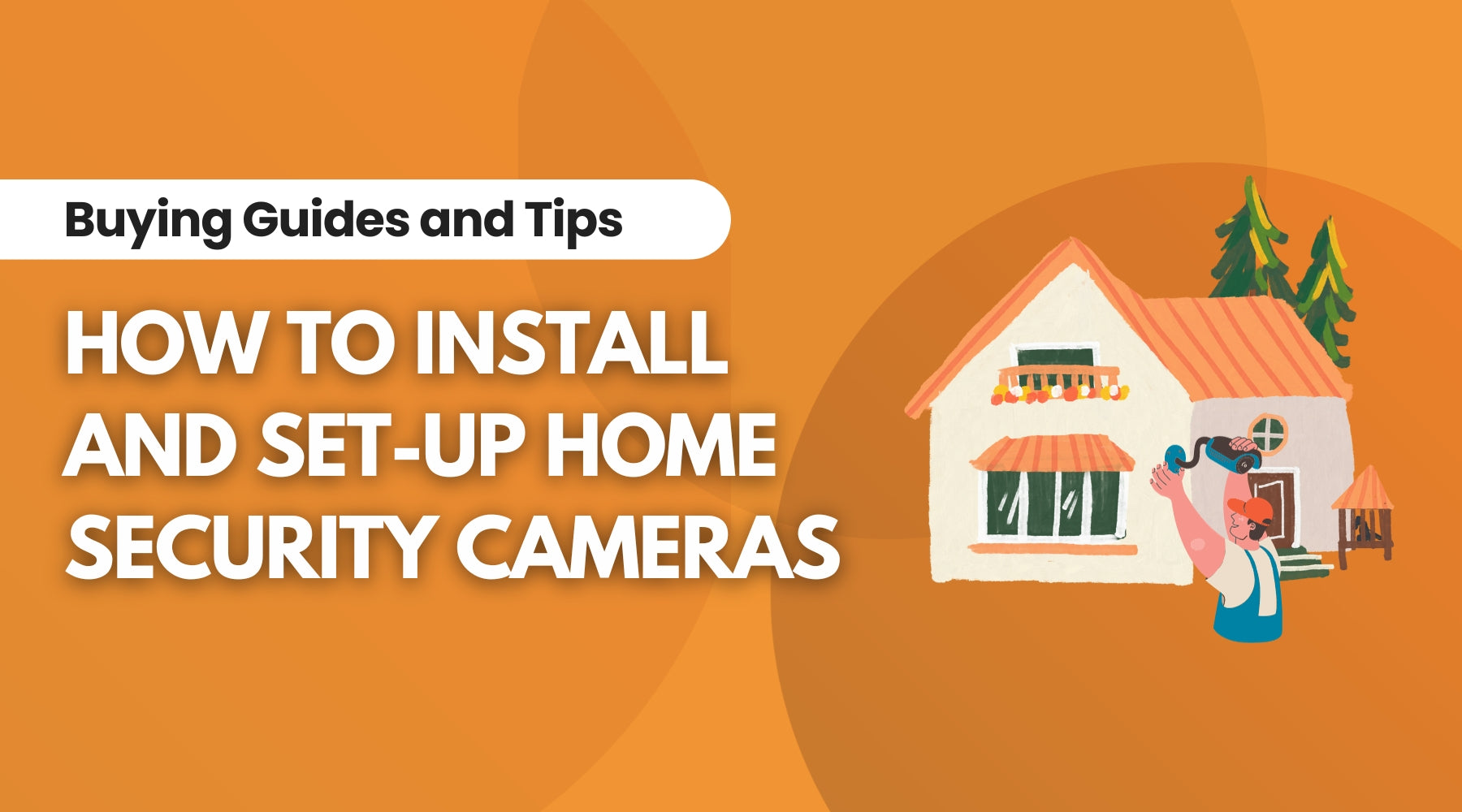
A Step-by-Step Guide to Home Security Camera Installation and Setup
In the article “Buying Guide for Home Security Cameras: How to Protect Your Property”, we learned the different types of home security cameras as well as the key factors to consider when buying one for you and your family. In this guide, we'll walk you through the step-by-step process of installing and setting up home security cameras.
FIRST STEP! Choose Between DIY and Professional Installation
The first decision you'll need to make is whether to opt for a DIY installation or hire a professional. The decision between DIY and professional installation boils down to your individual needs and preferences. Here are some factors to consider:
Key Factor 1: Technical Proficiency
Are you comfortable with technology, or do you prefer a hassle-free installation process?
Key Factor 2: Budget
What is your budget for installation, and are you willing to pay for professional services?
Key Factor 3: Time
How much time can you dedicate to set up, and do you need the system up and running quickly.
Key Factor 4: Complexity
Is your security system straightforward, or does it involve intricate components that may benefit from professional installation?
Both DIY and professional installation can result in an effective home security system. The choice depends on your unique circumstances and priorities. Whichever path you choose, the most important thing is to have a reliable security system in place to protect your home and loved ones. Furthermore, below are the pros and cons of each to help you make an informed decision.
DIY Installation
Pros:
- Cost Savings: DIY installation typically saves you money as you won't incur labour costs associated with professional installers.
- Flexibility: You have full control over the placement of your security devices, ensuring they cover the areas you deem most important.
- Timeliness: DIY installation often allows for quicker setup since you're not reliant on the availability of professional technicians.
- Learning Experience: It can be a valuable learning experience, helping you become more tech-savvy and familiar with your security system.
Cons:
- Technical Proficiency: DIY installation may require technical skills to set up the system correctly, which can be challenging for some users.
- Time and Effort: Installing and configuring the system can be time-consuming, particularly if you're not familiar with the technology.
- Potential Errors: Mistakes during installation can compromise the system's effectiveness and security.
Professional Installation
Pros:
- Expertise: Professional installers are trained and experienced, ensuring your security system is set up correctly and optimally.
- Time-Efficient: Professionals can complete the installation quickly, minimising downtime and disruptions.
- Technical Support: You have access to technical support and troubleshooting if issues arise.
- Warranty Compliance: Professional installation often ensures that your system's warranty remains valid.
Cons:
- Cost: Professional installation typically comes with a cost, which can vary depending on the complexity of the setup.
- Limited Flexibility: You may have less control over the placement of devices, as professionals follow standard practices for optimal coverage.
- Scheduling: Coordinating with professional installers may require you to adjust your schedule.
Placement Tips for Maximum Coverage
Proper camera placement is crucial for ensuring your security cameras cover the areas you want to monitor. Here are some placement tips:
- Entry Points: Install cameras near all entry points, such as doors and windows.
- High Traffic Areas: Focus on areas with high foot traffic, both indoors and outdoors.
- Vantage Points: Place cameras where they can capture a wide field of view without obstructions.
- Height: Install cameras at a height that's difficult to reach or tamper with.
- Consider Privacy: Be mindful of privacy concerns, avoiding cameras in sensitive areas like bedrooms or bathrooms.
How to Link Your Cameras to Your Home Network
Connecting your security cameras to your home network is essential for remote monitoring and access. Follow these steps:
Step 1: Choose a Secure Wi-Fi Network
The first and foremost step in connecting your security cameras to your home network is to select a secure Wi-Fi network. Here's what you need to consider:
- Network Security: Opt for a network with robust security features. Ensure it uses WPA3 encryption or at least WPA2 for protection against unauthorised access.
- Steady Connection: Choose a network with reliable coverage in the areas where you've installed or plan to install your cameras.
- Password Strength: Set a strong, unique password for your Wi-Fi network to prevent any potential breaches.
Step 2: Camera Setup
Once you've chosen a secure Wi-Fi network, it's time to set up your security cameras. Here's a general overview of what this entails:
- Unboxing: Begin by unboxing your cameras and ensuring you have all the necessary components, including power cables and mounting hardware.
- Power Up: Connect your cameras to a power source. Depending on the camera type, this could involve plugging them into electrical outlets or using batteries.
- Follow Manufacturer's Instructions: Each camera may have slightly different setup procedures. Refer to the manufacturer's instructions provided in the user manual or setup guide.
- Syncing with Your Network: Typically, you'll need to connect the camera to your Wi-Fi network during the setup process. Follow the on-screen prompts or app instructions to do this.
Step 3: Network Configuration
With your cameras connected to the Wi-Fi network, it's essential to configure their network settings for optimal performance. Here's what you need to do:
- Access Camera Settings: Open the camera's settings menu, usually accessible through the camera's mobile app or a web browser interface.
- Configure Wi-Fi: Look for the Wi-Fi or network configuration options. Enter the SSID (Wi-Fi network name) and password of your secure network.
- Additional Settings: Depending on your camera's features, you may have other network-related settings to configure, such as static IP addresses or port forwarding for remote access.
Step 4: Password Protection
Protecting your security cameras with strong, unique passwords is a critical step in preventing unauthorised access. Here's how to do it:
- Change Default Passwords: Many cameras come with default usernames and passwords. Change these immediately to something strong and unique.
- Password Management: Consider using a reputable password manager to generate and store complex passwords for your cameras.
- Enable Two-Factor Authentication (2FA): If your camera system supports it, enable 2FA for an added layer of security.
How to Configure Mobile App Access for Remote Monitoring
Most modern security cameras come with mobile apps that allow you to monitor your property remotely. Here's how to set up the mobile app:
Step 1: Download the App
The first step in accessing your security cameras remotely is to download the dedicated mobile app provided by your camera's manufacturer. Follow these steps:
- Search for the App: Open your device's app store, such as the Apple App Store for iOS devices or Google Play Store for Android devices.
- Find the App: Use the search function to locate the app. It's usually named after the camera brand or model.
- Download the App: Once you've found the app, click the "Download" or "Install" button. The app will automatically download and install on your device.
Step 2: Account Creation
To use the mobile app effectively, you'll need to create an account or sign in if you already have one. Here's what to do:
- Open the App: Launch the app on your device.
- Account Setup: Follow the on-screen instructions to create a new account. You may need to provide an email address and create a password.
- Verification: Verify your account through the confirmation email sent to your registered email address.
Step 3: Camera Pairing
The next crucial step is pairing your security cameras with your mobile app account. This process may vary slightly depending on your camera's brand and model, but generally, it involves the following:
- Open the App: Launch the app on your device.
- Add a Device: Look for an option to "Add a Device" or "Pair a Camera" within the app's menu.
- Follow App's Instructions: The app will guide you through the pairing process. Typically, this involves scanning a QR code on the camera or entering a unique device code.
Step 4: Camera Configuration
Once your camera is paired with the app, you can customise its settings to suit your preferences and security needs:
- Motion Detection: Configure motion detection settings, such as sensitivity levels and zones, to receive alerts when motion is detected.
- Notifications: Set up notifications to receive alerts on your device when specific events occur, such as motion detection or camera offline status.
- Alerts and Alarms: Customise alert and alarm settings, including the type of alert (email, push notification, or SMS) and the frequency.
Step 5: Remote Access
With your mobile app configured, you're now ready to access your security cameras remotely:
- Open the App: Launch the mobile app on your device.
- Select the Camera: Choose the camera you want to access from your list of paired devices.
- Live Video Feeds: Enjoy real-time live video feeds from your camera. You can pan, tilt, and zoom (if supported) for a better view.
- Review Footage: Access recorded footage and review past events through the app's interface.
- Receive Alerts: Stay informed with instant alerts and notifications about any events or detected motion.
By following these steps, you can effortlessly configure mobile app access for remote monitoring of your security cameras. This technology empowers you to keep an eye on your property, loved ones, and valuable assets from anywhere, enhancing your home security and providing you with peace of mind.
